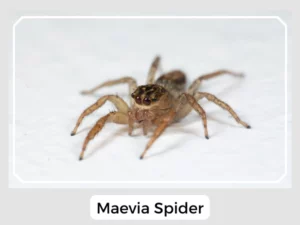The Maevia spider is a special type that’s part of the Salticidae family. You can find them all over North America, and there are eight main kinds right now. Some Maevia spiders have moved to different groups. While there are some in Asia, we don’t know a lot about them. In this post, we’ll tell you some neat facts about Maevia spiders.
The female Maevia spider protects her eggs by enclosing them in a fluffy sac.
Though there is a lack of accurate information about spiderlings of most species of this genus, they too disperse to be on their own upon maturation.
Belonging to the jumping spider family, Maevia spiders do not spin webs to catch their prey. Instead, they employ their silk in different ways and actively hunt, relying on their agility and sharp vision to stalk and capture smaller insects and other spiders.
Yes, Maevia Spiders have venom. They use it to catch small bugs they eat. But don’t worry, it’s not very strong for humans.
Maevia Spiders can bite, but they’re usually shy and avoid people. They’ll only bite if they really feel threatened.
Maevia spiders play a crucial role in controlling insect populations, contributing to the balance of their ecosystems. Their presence aids in keeping pest numbers in check, indirectly benefiting agriculture and human habitation. They exhibit fascinating behaviors, especially during mating displays where males perform intricate dances to attract females.
Natural Predators: Despite their agility and sharp vision, Maevia spiders are not free from predators. Birds and larger spiders pose a threat to them. Their small size and ground-dwelling habits make them vulnerable, yet their agility and quick reflexes help them in their survival.
Prey-Predator Dynamics: The Maevia spider is an active participant in its ecological food web. It helps manage insect populations, serving as both predator and prey. This delicate balance is crucial for the stability and health of their habitats.
Relationship with Humans: Maevia spiders coexist peacefully with humans, often residing in gardens where they help control pest populations. Their fascinating behaviors and unique appearance have caught the attention of spider enthusiasts, contributing to a greater understanding of these tiny predators.
| Distribution | Parts of North America, Canada, as well as the Indonesian Islands |
| Habitat | Forests, human-made structures |
| Diet | Smaller insects and other spiders |
| Lifespan | About 1 year |

In summary, the Maevia spider, with its unique characteristics, plays an important role in maintaining ecological balance and offers a fascinating glimpse into the world of small predators.
The Maevia spider is a special type that’s part of the Salticidae family. You can find them all over North America, and there are eight main kinds right now. Some Maevia spiders have moved to different groups. While there are some in Asia, we don’t know a lot about them. In this post, we’ll tell you some neat facts about Maevia spiders.
The female Maevia spider protects her eggs by enclosing them in a fluffy sac.
Though there is a lack of accurate information about spiderlings of most species of this genus, they too disperse to be on their own upon maturation.
Belonging to the jumping spider family, Maevia spiders do not spin webs to catch their prey. Instead, they employ their silk in different ways and actively hunt, relying on their agility and sharp vision to stalk and capture smaller insects and other spiders.
Yes, Maevia Spiders have venom. They use it to catch small bugs they eat. But don’t worry, it’s not very strong for humans.
Maevia Spiders can bite, but they’re usually shy and avoid people. They’ll only bite if they really feel threatened.
Maevia spiders play a crucial role in controlling insect populations, contributing to the balance of their ecosystems. Their presence aids in keeping pest numbers in check, indirectly benefiting agriculture and human habitation. They exhibit fascinating behaviors, especially during mating displays where males perform intricate dances to attract females.
Natural Predators: Despite their agility and sharp vision, Maevia spiders are not free from predators. Birds and larger spiders pose a threat to them. Their small size and ground-dwelling habits make them vulnerable, yet their agility and quick reflexes help them in their survival.
Prey-Predator Dynamics: The Maevia spider is an active participant in its ecological food web. It helps manage insect populations, serving as both predator and prey. This delicate balance is crucial for the stability and health of their habitats.
Relationship with Humans: Maevia spiders coexist peacefully with humans, often residing in gardens where they help control pest populations. Their fascinating behaviors and unique appearance have caught the attention of spider enthusiasts, contributing to a greater understanding of these tiny predators.
| Distribution | Parts of North America, Canada, as well as the Indonesian Islands |
| Habitat | Forests, human-made structures |
| Diet | Smaller insects and other spiders |
| Lifespan | About 1 year |

In summary, the Maevia spider, with its unique characteristics, plays an important role in maintaining ecological balance and offers a fascinating glimpse into the world of small predators.